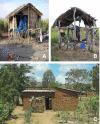Malaria risk and access to prevention and treatment in the paddies of the Kilombero Valley, Tanzania
- PMID: 18184430
- PMCID: PMC2254425
- DOI: 10.1186/1475-2875-7-7
Malaria risk and access to prevention and treatment in the paddies of the Kilombero Valley, Tanzania
Abstract
Background: The Kilombero Valley is a highly malaria-endemic agricultural area in south-eastern Tanzania. Seasonal flooding of the valley is favourable to malaria transmission. During the farming season, many households move to distant field sites (shamba in Swahili) in the fertile river floodplain for the cultivation of rice. In the shamba, people live for several months in temporary shelters, far from the nearest health services. This study assessed the impact of seasonal movements to remote fields on malaria risk and treatment-seeking behaviour.
Methods: A longitudinal study followed approximately 100 randomly selected farming households over six months. Every household was visited monthly and whereabouts of household members, activities in the fields, fever cases and treatment seeking for recent fever episodes were recorded.
Results: Fever incidence rates were lower in the shamba compared to the villages and moving to the shamba did not increase the risk of having a fever episode. Children aged 1-4 years, who usually spend a considerable amount of time in the shamba with their caretakers, were more likely to have a fever than adults (odds ratio = 4.47, 95% confidence interval 2.35-8.51). Protection with mosquito nets in the fields was extremely good (98% usage) but home-stocking of antimalarials was uncommon. Despite the long distances to health services, 55.8% (37.9-72.8) of the fever episodes were treated at a health facility, while home-management was less common (37%, 17.4-50.5).
Conclusion: Living in the shamba does not appear to result in a higher fever-risk. Mosquito nets usage and treatment of fever in health facilities reflect awareness of malaria. Inability to obtain drugs in the fields may contribute to less irrational use of drugs but may pose an additional burden on poor farming households. A comprehensive approach is needed to improve access to treatment while at the same time assuring rational use of medicines and protecting fragile livelihoods.
Figures





Similar articles
-
Household and socioeconomic factors associated with childhood febrile illnesses and treatment seeking behaviour in an area of epidemic malaria in rural Ethiopia.Trans R Soc Trop Med Hyg. 2007 Sep;101(9):939-47. doi: 10.1016/j.trstmh.2007.04.018. Epub 2007 Jun 28. Trans R Soc Trop Med Hyg. 2007. PMID: 17602716
-
Social determinants of malaria and health care seeking patterns among rice farming and pastoral communities in Kilosa District in central Tanzania.Acta Trop. 2015 Apr;144:41-9. doi: 10.1016/j.actatropica.2015.01.003. Epub 2015 Jan 14. Acta Trop. 2015. PMID: 25596436
-
Conquering the intolerable burden of malaria: what's new, what's needed: a summary.Am J Trop Med Hyg. 2004 Aug;71(2 Suppl):1-15. Am J Trop Med Hyg. 2004. PMID: 15331814 Review.
-
Prevalence of malaria parasitemia among clients seeking treatment for fever or malaria at drug stores in rural Tanzania 2004.Trop Med Int Health. 2006 Apr;11(4):441-51. doi: 10.1111/j.1365-3156.2006.01588.x. Trop Med Int Health. 2006. PMID: 16553927
-
Treatment seeking for malaria in Morong, Bataan, the Philippines.Soc Sci Med. 2000 May;50(9):1309-16. doi: 10.1016/s0277-9536(99)00379-2. Soc Sci Med. 2000. PMID: 10728850 Review.
Cited by
-
Obstacles to prompt and effective malaria treatment lead to low community-coverage in two rural districts of Tanzania.BMC Public Health. 2008 Sep 16;8:317. doi: 10.1186/1471-2458-8-317. BMC Public Health. 2008. PMID: 18793448 Free PMC article.
-
Retrospective Analysis of Malaria Cases in a Potentially High Endemic Area of Morogoro Rural District, Eastern Tanzania.Res Rep Trop Med. 2020 Jun 12;11:37-44. doi: 10.2147/RRTM.S254577. eCollection 2020. Res Rep Trop Med. 2020. PMID: 32607048 Free PMC article.
-
Knowledge, perception and practices about malaria, climate change, livelihoods and food security among rural communities of central Tanzania.Infect Dis Poverty. 2015 Apr 24;4:21. doi: 10.1186/s40249-015-0052-2. eCollection 2015. Infect Dis Poverty. 2015. PMID: 25914808 Free PMC article.
-
High vector diversity and malaria transmission dynamics in five sentinel sites in Cameroon.Malar J. 2023 Apr 13;22(1):123. doi: 10.1186/s12936-023-04552-z. Malar J. 2023. PMID: 37055836 Free PMC article.
-
Who gets prompt access to artemisinin-based combination therapy? A prospective community-based study in children from rural Kilosa, Tanzania.PLoS One. 2010 Aug 10;5(8):e12104. doi: 10.1371/journal.pone.0012104. PLoS One. 2010. PMID: 20856897 Free PMC article.
References
Publication types
MeSH terms
LinkOut - more resources
Full Text Sources
Medical

